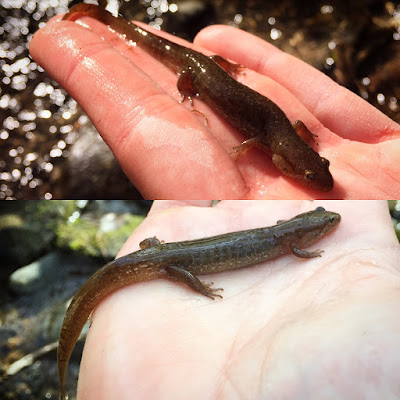Jefferson Salamander
Looks Like: Dark brown to gray body with a lighter underside. Blue-gray speckles are on the limbs and lower sides of the body. Jefferson Salamanders can be 4.25” to 8.25” in length. They have a wide snout, a long and slender body. And a tail that almost extends the length of the body.
 Lives In: Upland deciduous forests that feature moist, rocky outcrops. They prefer to live underground under rotting logs.
Lives In: Upland deciduous forests that feature moist, rocky outcrops. They prefer to live underground under rotting logs.
Niche: Jefferson Salamanders’ diet includes worms, insects, snails, and slugs. This species is often prey for owls, snakes, striped skunks, and raccoons.
Threats: In dry spring times, many young Jefferson Salamander in temporary vernal pools can die before they mature enough to leave the pool before it dries up. As their pond dries and the water level declines they also become more vulnerable to predators. With climate change, the wide fluctuation in the occurrence and amount of precipitation during spring and summer and lack of snow cover in winter can pose major risks for this salamander’s survival. Acidic rain at breeding time can cause embryonic mortality. Loss of small unregulated wetlands is also a major threat.
Frequency: These salamanders are rare to find except for breeding nights in late winter and early spring. An average lifespan of Jefferson Salamanders is three years.
Reproduction: Jefferson Salamanders will breed in woodland, vernal pools. They will emerge on rainy nights and migrate to pools when the ground is partially thawed and ice still on pools. When the males and females locate each other (by chemical communication), the males will entice the females with snout rubbing, clasping, and synchronized swimming and tail waving. The female will pick up the male’s released spermatophores in her cloaca and will lay up to 250 eggs in small clusters a few days later. The egg masses are tubular and clear, attached to twigs and soft vegetation. Eggs will hatch 4-6 weeks later and the larvae will complete development after 2-4 months.
Fun Fact: The Jefferson Salamander is involved in a hybrid complex with three other species of salamanders – the Blue-Spotted Salamander, the Small-Mouth Salamander, and the Tiger Salamander.
No comments:
Post a Comment